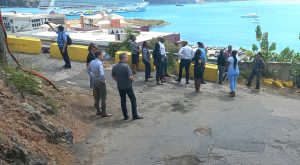Shortly after 10 a.m. last Thursday morning, sirens blared across the Virgin Islands and police officers took to the streets of Road Town to urge residents to climb to higher ground and assemble at designated evacuation points.
The evacuation was part of the Carib Wave 23tsunami response drill, which also included other countries and territories around the region, according to the Department of Disaster Management.
At the Beacon, an officer knocked on the door to enquire who was in the building. At the time, the staff members were al-ready on their way to join other residents walking up Russell Hill Road to safe ground.

“I just saw a notification on my phone,” one resident said. The exercise simulated a tsunami caused by a collapse of the Mount Pelée volcano in Martinique, according to DDM.
Among other benchmarks, it tested the territory’s response by activating the National Early Warning Multi-hazard Alert System, which includes public notifications via emergency siren, radio, the DDM app, social media and other tools. “Overall, the exercise went very well, with about 3,000 total participants,” DDM Training Manager Carishma Hicks told the Beacon
Participation
She added that agencies within the public and private sec-tor took part. “We saw great support, especially in the primary schools and early childhood education centres, doing full drop, cover and hold drills in addition to evacuation inland or to high ground,”Ms.Hicks said.
The BVI Autism Centre and BVI Services also took part, she added. Ms. Hicks thanked key partner agencies including the Royal Virgin Islands Police Force, the Fire and Rescue Service, the BVI Health Services Authority, the BVI Airports Authority, and the BVI Ports Authority.
“As a department, were able to successfully activate our emergency communications, including the sirens, broadcast alerts, satellite phones, high frequency radio and VHF radio,” she said. In addition, there was a successful activation of the portable emergency FM frequency ZEOC 88.7 FM, she added.
“We had support from local broadcasters airing messages to make sure that persons were aware of the exercise and what to do in case of a real threat,” Ms.Hicks said. Large and small businesses, she added, used the drill to review their response plans and train staff on how to respond safely in case of a tsunami warning.
Complaints
But not everyone got the message. In a Facebook post, a resident inquired about whether a drill was in progress, since she was hearing the sirens in her area but was unaware of their purpose.
Sharon Burrill noted that she received an SMS message on her phone around 11:03 a.m. — an hour late — and two other people said they hadn’t received such messages at all.
Another resident said he could hardly hear the siren from the area of the Virgin Gorda Police Station. Ms. Hicks said DDM recognises that its siren network does not cover 100 percent of the territory. Adding new sirens, she said, is part of the agency’s plan for 2023.
Regarding the SMS messages, she described cell tower delays. “Because of technological limitations with local cell towers, the Virgin Islands doesn’t have the cell broadcast capability that persons might know about from things like amber alerts,” she said. “Based on those limitations, mass SMS messages can take time for users to receive.”
Learning experience
The drill, she said, was a learning experience in this regard as well. “We were glad to have the mobile providers’ support by their sharing of an awareness message about the exercise,” she said. “We also encourage persons to have more than one way to receive emergency information — for example, the DDM app, radio, and social media notifications.”